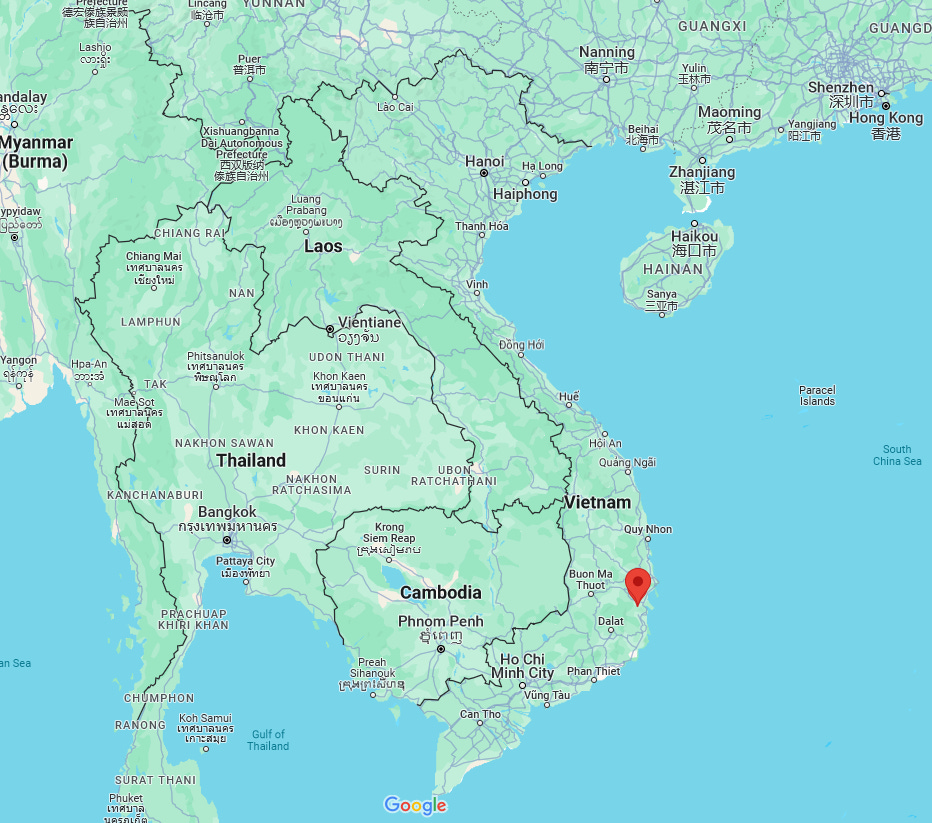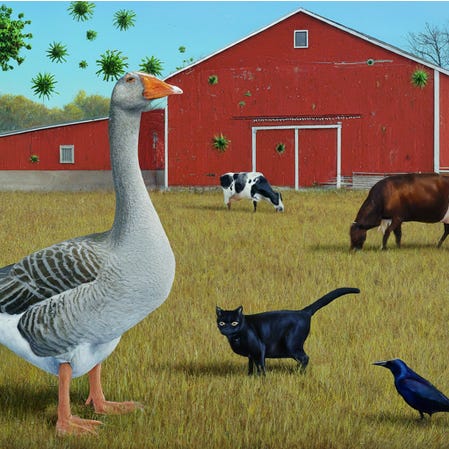The Bird Flu Crisis Deepens: Novel H5N1 Variant Emerges Amid Fatality of a 21-Year-Old Student in Vietnam
CDC Issues Alert to States - Get Prepared for Human Infections of H5N1 as Dairy Farm Outbreaks Spread
Amidst a growing global concern, a chilling new threat emerges from the realm of bird flu. Recent revelations by animal health officials in Vietnam and the United Nations Food and Agriculture Organization (FAO) unveil a troubling development: the detection of a novel reassortant strain of highly pathogenic avian influenza (HPAI) H5N1 virus across the Greater Mekong Subregion (GMS). This newfound variant, a blend of two distinct H5N1 clades, casts a shadow of concern over both animal and human health in the region. Adding to the gravity of the situation, a 21-year-old student succumbed to bird flu (H5N1), emphasizing the urgency of dissecting this complex scenario. In this report, we'll break down the situation and what it means going forward.
If you can, please consider supporting TACT by becoming a paid subscriber. You not only gain access to exclusive content but also play a pivotal role in sustaining this critical endeavor. Join us in our mission by becoming a valued subscriber today, ensuring that crucial information and insights continue to be available to everyone. TACT is read in 52 countries and 48 U.S. states. Your support is crucial to help sustain this work. A heartfelt thank you to our existing paid subscribers for their invaluable support!
The Anatomy of a Potentially Dangerous Reassortment
The new H5N1 variant is a reassortment between an older H5N1 clade, 2.3.2.1c, that has been circulating locally in parts of Asia, and a more recently emerged global clade, 2.3.4.4b. By combining genetic material from these two distinct H5N1 lineages, this novel virus has the potential to exhibit enhanced transmissibility and adaptability.
Widespread Circulation Across the GMS
The GMS, which encompasses Cambodia, Laos, Myanmar, Thailand, Vietnam, and parts of China, is a biodiversity hotspot with a population of over 326 million people. The introduction and spread of a new reassortant H5N1 virus across this vast region is particularly concerning, given the historical impact of HPAI outbreaks in the area.
Active surveillance in Vietnam has revealed the continued circulation of both the 2.3.2.1c and 2.3.4.4b H5N1 clades nationwide, with some instances of reassortment detected in the southern provinces. This suggests the new variant may already be established in poultry populations across the region. (1)
2.3.4.4b is the variant that has been spreading in the United States, recently infecting dairy cows, goats, and cats. The spread encompasses at least 16 farms in 6 states. At least up until now, the new variant combination found in Vietnam hasn’t been found outside of this region.
The Tragic Death of a 21-Year-Old Student
The emergence of this novel H5N1 virus coincides with the tragic death of a 21-year-old college student in Vietnam's Khanh Hoa province. The student, who lived in a village near Ninh Hoa, Vietnam had a history of wild bird trapping before and after the Lunar New Year.
The sequence of events began on March 11, 2024, when the 21-year-old student started experiencing symptoms of fever and cough. His symptoms persisted and continued to worsen, so on March 16 or 17, 2024, he sought medical attention at the Ninh Hoa Medical Center. Subsequently, due to the worsening condition and a diagnosis of pneumonia, the patient was transferred to Khanh Hoa General Hospital.
On March 19, 2024, the Khanh Hoa Disease Control Center took samples from the patient for testing. The test results revealed on March 20, 2024, the presence of A/H5 flu. Tragically, due to the severity of the illness, the patient passed away on March 23, 2024.
The genetic analysis by the Pasteur Nha Trang Institute on March 22, 2024, definitively identified the patient as positive for an influenza A (H5N1) subtype, but they don’t reveal what the subtype is. This is an important unanswered question.
An epidemiological investigation revealed that the patient had engaged in wild bird trapping activities near the vicinity of his residence before and after the Chinese New Year in 2024. The timeline between the potential exposure, and the onset of symptoms suggests a significant delay, possibly indicating a prolonged incubation period or another source for the infection. The case gets more mysterious because there were no reports of sick or dead poultry in the area of his home. Close contacts of the patient were supposedly closely monitored for symptoms, with no new cases detected according to an investigation's findings. (2) It does say that they tested close contacts, only that they monitored symptoms, leaving the door open for the possibility of asymptomatic infections.
The tragic death of this previously healthy young man is a reminder of how deadly an H5N1 infection can be and why we need to take these developments occurring in Vietnam and the U.S. very seriously.
With that said, the cumulative number of people infected with influenza A (H5N1) in Vietnam from 2003 to the present, was 128 people, of which 65 were killed. That gives us a fatality rate of 50.8%. (2) This tells us that despite circulation in birds, it rarely jumps to people in Vietnam. When it does, it is often deadly. The recent development of the recombinant H5N1 variant and the death is very concerning. We certainly hope that this was one of the rare cases, but we will have to watch closely to make sure other cases don’t surface. Hopefully, we will discover the subtype this student was infected with.
CDC Issues Warning to States - Get Prepared for Human Infections
On April 5, 2024, the “CDC officials emphasized that the risk to the public remains low, however, it is encouraging state public health officials to be prepared to respond."
"The CDC is recommending that state public health officials engage with state veterinarians and agriculture department officials to ensure that they have up-to-date operational plans to respond to avian influenza at the state level." (3)
Why is the CDC recommending preparedness for more human cases of avian flu (H5N1)?
As stated above, at least 16 dairy farms in 6 states are reporting outbreaks, increasing the odds of transmission to goats, cats, and other farm animals. That means much greater odds of transmission to humans.
The more animal species it is evolving in and potentially more humans, the greater the risk of an evolutionary jump enabling human-to-human transmission. It's crucial to recognize that one of the deadliest influenza viruses in history, the Spanish influenza (1918–1919), originated from an avian influenza virus that adapted to infect humans.
The 1918-1919 influenza pandemic killed over 40 million people at a time when international air travel and the interstate highway system didn’t exist yet. Imagine how that would look today.
”This historical precedent underscores the importance of considering the potential for spillover when assessing the risk posed by the current virus." (4)
627K Mutation Discovered in the Human Infected in Texas and Increased Disease Severity
The mutation discovered in the Texan man is not an isolated event. It occurred in a human host with the H7N9 virus. Although fortunate that the individual from Texas recovered with antiviral treatment, the swift mutation process and these findings are crucial points to note.
"The intrahost dynamic adaptation was confirmed by the gradual replacement of 627E by 627K in H7N9 in the longitudinally collected specimens from one patient. These results suggest that host adaptation for better virus replication to new hosts, termed "genetic tuning," actually occurred in H7N9-infected patients in vivo. Notably, our findings also demonstrate the correlation between rapid host adaptation of H7N9 PB2-E627K and the fatal outcome and disease severity in humans.” (5)
The Urgent Need for Vigilance and Action
The recent discovery of a novel reassortant H5N1 virus, alongside a tragic human fatality in Vietnam and the escalating outbreaks in dairy farms across the United States, highlights an urgent call to action. Heightened surveillance, stringent biosecurity measures, and increased public awareness are imperative to combat this evolving threat. It's crucial for stakeholders across various sectors, including poultry, dairy, beef, and goat farming, as well as traders, veterinarians, and the general public, to remain vigilant.
Recognizing the expanding range of species susceptible to H5N1 infection, individuals must promptly report any symptoms indicative of the virus and avoid contact with sick or deceased birds, as well as other animals like cats, dogs, cows, and more.
Find the symptoms in humans, cows, poultry, and wild birds HERE.
Proper personal protective equipment (PPE), such as N-95 masks, should be worn when handling potentially infected animals or individuals.
With the continued circulation and potential evolution of this novel H5N1 variant, coupled with the increasing outbreaks in U.S. dairy farms, the risk of zoonotic transmission to humans grows ever more significant. It's imperative to take proactive measures to monitor, contain, and prepare for the potential threat posed by this dangerous virus. The Greater Mekong Subregion, the United States, and indeed the entire world must unite in safeguarding both animal and human health.
Moreover, with the ongoing airborne transmission of viruses like SARS-CoV-2, RSV, and seasonal influenza strains, investments in air filtration and ventilation systems are paramount. COVID and now H5N1, avian influenza are evolving and the potential for increased virulence is ever-present. These measures not only protect against current threats but also fortify defenses against potential future outbreaks. Enhancing air quality not only benefits public health but also contributes to education, economic prosperity, and overall quality of life, ultimately prolonging lifespans. Delaying action in preventing airborne transmission is dangerous; therefore, decisive steps must be taken to mitigate these risks.
Share your thoughts, questions, stories, insights, and/or information.
For more information:
Avian Influenza A (H5N1) in Cats, Cows, and Humans: Symptoms, Timeline, Antiviral Therapies, and Vaccine Development - A Comprehensive Review
H5N1 Avian Influenza: A Critical Update H5N1 has now been detected in dairy cows in multiple states in the United States. A human case in Texas linked to this outbreak underscores the potential for this deadly virus to jump species. Here's what you need to know.








Ground up chicken waste fed to cattle. Reminds me of Bovine Spongiform Encephalopathy saga from a generation ago. (History doesn't repeat...but it rhymes)
(By the way...up to 20 dairy farms now) If it's in the feed...
https://www.telegraph.co.uk/global-health/science-and-disease/chicken-waste-fed-to-cattle-may-be-behind-bird-flu-outbreak/
Houston...we have a problem. Check out quote below (Regrettably, source is paywalled)
AND it just turned up in North Carolina...
"Texas state epidemiologist Dr. Jessie Monday, says that 40 dairy farms in Texas had reported seeing the syndrome in their herds. Texas’ commissioner of agriculture estimated that the syndrome was present in 40% of the dairy herds in West Texas and the Texas Panhandle in Feb-March"
https://www.barrons.com/articles/bird-avian-flu-outbreak-texas-cows-news-latest-3a5fbfb0